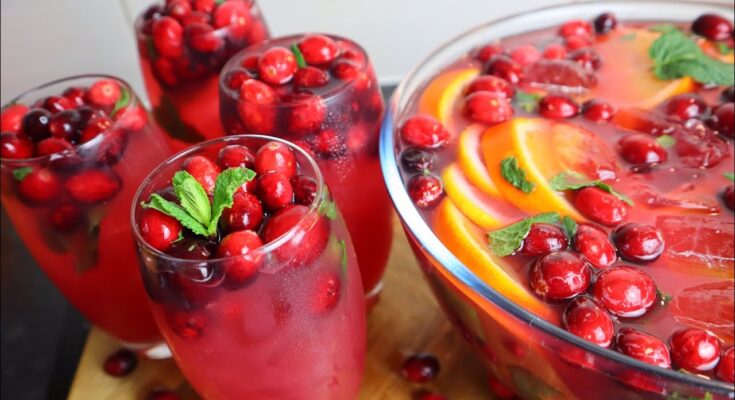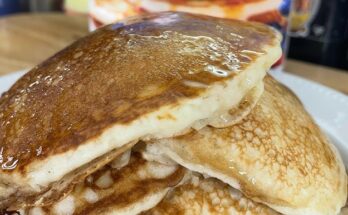Cranberry Juice Recipe: Making your own cranberry juice at home is like bottling up a burst of tart freshness with a healthy punch. It’s surprisingly easy, and the results are far better than what you’d pick up off the store shelf. Homemade cranberry juice means you control the ingredients—no added preservatives, artificial sweeteners, or unnecessary sugar bombs. Just pure, tangy goodness.
But beyond being just a beverage, cranberry juice is a superpower in a glass. Whether you’re sipping it for its tart taste or its body-boosting benefits, there’s no denying its place as a kitchen essential. In this guide, we’re walking you through exactly how to make cranberry juice from scratch, step-by-step, with everything you need to know to nail it on the first try.
We’ll also cover how to tweak it, store it, and even jazz it up with flavor combos that’ll make your taste buds dance. Let’s get started!
Why Make Homemade Cranberry Juice?
Sure, grabbing a bottle of cranberry juice off the grocery shelf is convenient. But when you actually stop to read the label, it might surprise you—most commercial cranberry juices are loaded with added sugars, flavorings, and preservatives. Some even contain as little as 15% real cranberry juice!
Homemade cranberry juice, on the other hand, gives you full control over the taste, ingredients, and quality. Want it less sweet? You can adjust that. Prefer a hint of citrus or spice? Go for it. Making it yourself means no surprises—just real fruit, real nutrients, and real flavor.
Plus, the freshness of homemade juice just hits differently. The flavor is brighter, the color richer, and the benefits more potent. It’s also a fun way to experiment in the kitchen. Not to mention, cranberries are often cheaper in bulk, especially during the fall and winter seasons, so you get more juice for your buck.
In short? Homemade cranberry juice is healthier, tastier, and way more satisfying.
Health Benefits of Cranberries
Cranberries might be small, but they pack a serious nutritional punch. They’re rich in antioxidants, particularly proanthocyanidins, which are known to help prevent urinary tract infections (UTIs). But that’s just the start.
Here are a few more health benefits of cranberries:
- Supports Urinary Tract Health: The most well-known benefit. Cranberries prevent bacteria from sticking to the walls of the urinary tract.
- Boosts Immune System: Thanks to their vitamin C content and antioxidants.
- Heart Health: Cranberries may improve cholesterol levels and reduce blood pressure.
- Anti-Inflammatory Properties: The antioxidants help reduce inflammation in the body.
- Digestive Health: Cranberries support gut health by promoting good bacteria.
Drinking cranberry juice regularly—especially the homemade kind with no sugar overload—can be a delicious way to support your body naturally.
Is Store-Bought Cranberry Juice Healthy?
It depends. Many commercial brands dilute cranberry juice with water, add loads of sugar, and mix in other juices like apple or grape to balance the tartness. While that makes it more palatable, it seriously reduces the health benefits.
Some store-bought juices are labeled “100% juice,” which is better—but still, read the fine print. Even those can include juices from concentrate or be pasteurized to the point of reduced nutritional value.
If you’re looking for health benefits, go for unsweetened cranberry juice or, better yet, make it at home. That way, you skip all the additives and get the full potency of the fruit. Think of store-bought as cranberry-flavored sugar water—and your homemade version as the real deal.
List of Ingredients You’ll Need
Here’s what you need to whip up a batch of fresh cranberry juice:
Basic Ingredients:
- Fresh or frozen cranberries – 4 cups (about 1 pound)
- Water – 6 cups (for boiling)
- Sweetener of choice – to taste (e.g., honey, maple syrup, cane sugar)
Optional Add-ins:
- Cinnamon stick – for warm spice
- Orange peel or slices – adds citrusy depth
- Cloves or star anise – for holiday flavors
- Lemon juice – to brighten up the flavor
Fresh vs. Frozen Cranberries
- Fresh: Offers a bolder, tarter taste. Ideal when in season (fall-winter).
- Frozen: Available year-round and just as nutritious. No need to thaw before cooking.
Sweetener Options
- Natural: Honey, maple syrup, agave.
- Processed: White or brown sugar.
- Low-calorie: Stevia, monk fruit (if you’re cutting back on sugar).
Tailor the sweetness to your liking. Start low—you can always add more later, but you can’t take it out once it’s in!
Kitchen Tools Required
Don’t worry, you won’t need a juicer or any fancy gadgets. Here’s what you do need:
- Large saucepan or stockpot – to boil the cranberries.
- Wooden spoon or potato masher – to break down the berries.
- Fine mesh strainer or cheesecloth – for straining the juice.
- Pitcher or glass bottles – to store your finished juice.
- Measuring cups – for precision.
- Funnel (optional) – makes bottling easier.
With just these basic tools, you’re ready to juice like a pro in your own kitchen.
How to Choose the Best Cranberries
Fresh cranberries should be firm, plump, and bright red. Avoid any that look shriveled, mushy, or have brown spots. If buying frozen, check the bag for ice crystals—too much could mean they’ve been thawed and refrozen.
If you’re getting them fresh during the holiday season, stock up! You can freeze them in airtight bags and use them for juice all year long. Just rinse before use—no thawing needed.
How to Prepare Cranberries for Juicing
Start with a good rinse. Even if your cranberries look clean, give them a wash in cool water to remove any residue or dirt.
Next, sort through the berries and toss any that are squishy, moldy, or discolored. If you’re using frozen berries, you can skip this step since most frozen options are pre-sorted and ready to go.
For extra flavor, consider adding zest or juice from an orange or lemon before cooking. It adds a brightness that complements the tart cranberry beautifully.
Step-by-Step Guide to Making Cranberry Juice
Step 1: Washing and Sorting the Berries
Start by placing your fresh cranberries in a large bowl. Rinse thoroughly under cold water to remove dirt and debris. Sort through them and discard any shriveled, soft, or discolored berries. Good cranberries should feel firm and bounce slightly when dropped—those are the flavor stars.
Step 2: Boiling the Cranberries
Transfer the cleaned cranberries to a large pot and add enough water to cover them completely. Bring to a boil over medium-high heat. Once boiling, reduce to a simmer and let the berries cook for about 10 minutes. You’ll notice them popping open—this is exactly what you want, as it releases their tart juices.
Step 3: Mashing and Straining
Use a spoon or potato masher to gently crush the softened cranberries. Then pour the mixture through a fine mesh strainer or cheesecloth into a large bowl or pitcher. Press to extract as much juice as possible.
Step 4: Sweetening and Flavoring
Return the strained juice to the pot. Add sugar or honey to taste (cranberries are naturally tart, so adjust based on your preference). A squeeze of orange or a cinnamon stick can add warmth and depth.
Step 5: Cooling and Bottling
Let the juice cool completely, then pour into clean bottles or jars. Refrigerate and enjoy chilled.
Tips for Making the Perfect Cranberry Juice
Perfecting your homemade cranberry juice isn’t rocket science—but a few smart tips can take your juice from good to incredible. Whether you’re making it for a holiday gathering or sipping it daily for health, these tricks can help you get the most flavor, balance, and freshness.
1. Don’t Overcook the Cranberries
Once cranberries start bursting and softening, they’re ready. Overcooking can make the juice bitter and murky. Aim for 15–20 minutes on a gentle simmer. Too long on the heat and the vibrant flavor starts to fade.
2. Taste as You Go
Cranberry juice is naturally tart—some love it that way, others might need a little sweet touch. Instead of dumping in a bunch of sugar at once, add your sweetener gradually. Taste after each addition so you land on your perfect balance.
3. Add Flavor Layers
Cranberries have a bold flavor that pairs well with spices and citrus. Want a festive, cozy vibe? Toss in a cinnamon stick or a few whole cloves. Want it bright and refreshing? Add orange zest or fresh lemon juice.
4. Strain Twice for a Smoother Finish
If you prefer your juice silky-smooth, strain it twice—once through a mesh strainer, and a second time through cheesecloth or a nut milk bag. This removes any lingering pulp or grit.
5. Chill Before Serving
Homemade cranberry juice tastes best when cold. Let it cool fully before bottling, and give it a few hours in the fridge. It’ll mellow out and taste even better the next day.
Making great juice is part recipe, part intuition. With a little practice, you’ll nail your perfect method—and you’ll never look at store-bought juice the same way again.
How to Store Homemade Cranberry Juice
Once you’ve made your juice, the next question is: how do I store it properly? The good news is, homemade cranberry juice stores really well—as long as you follow a few simple rules.
Refrigerator Storage
- Use clean, airtight glass jars or bottles—preferably sterilized.
- Cool the juice completely before sealing to prevent condensation.
- Label with the date so you know how fresh it is.
In the fridge, your juice will stay fresh for up to 10–14 days. If it starts to smell off, taste fermented, or look cloudy, it’s time to toss it.
Use Glass, Not Plastic
Glass containers are best because they don’t absorb flavors or leach chemicals. Plus, cranberry juice’s natural acidity can sometimes react with certain plastics over time.
Keep It Cold
Always refrigerate your juice. Leaving it at room temp—even for a few hours—can promote bacterial growth and spoil the flavor.
Don’t Double Dip
When pouring or serving, avoid dipping used utensils or fingers into the bottle. This helps keep the juice clean and extends shelf life.
How Long Does Homemade Cranberry Juice Last?
Homemade cranberry juice has a decent shelf life, especially if properly stored in the fridge. On average:
- Refrigerated: Lasts 10–14 days
- Frozen: Lasts up to 6 months
But remember, this is assuming you’re working with fresh, clean ingredients and sterilized containers. If you notice any of these signs, discard it:
- Foul or sour odor
- Mold near the bottle cap or surface
- Fizzy or carbonated texture (sign of fermentation)
Want your juice to last even longer? You can preserve it by freezing or canning.
Can You Freeze Cranberry Juice?
Absolutely! Freezing is one of the best ways to extend the life of homemade cranberry juice without compromising its taste or quality.
How to Freeze Cranberry Juice
- Cool the Juice Completely: Never freeze hot or warm juice.
- Use Freezer-Safe Containers: Mason jars (leave headspace), silicone ice cube trays, or BPA-free freezer bags.
- Label and Date: Write the date and contents on the container.
- Freeze Flat (if using bags): Makes for easier stacking and faster thawing.
Frozen juice can last up to 6 months. When ready to use, thaw in the fridge overnight. Avoid thawing at room temp, which can lead to bacterial growth.
You can even freeze it in ice cube trays and pop a few cubes into water or sparkling water for a refreshing drink.
Cranberry Juice Recipe Variations
One of the joys of making your own juice is getting creative. Cranberries play well with other fruits, herbs, and spices. Here are a few delicious variations to try:
Cranberry Apple Juice
- Ingredients: Add 2 sliced apples (no need to peel) to your cranberry boil.
- Flavor: Adds natural sweetness and mellow apple flavor. Great for kids or those who find cranberries too tart.
- Tip: Fuji, Gala, or Honeycrisp apples work best.
Spiced Cranberry Juice
- Ingredients: Cinnamon stick, cloves, star anise, a pinch of nutmeg.
- Flavor: Cozy, warming, and perfect for fall or winter.
- Tip: Simmer the spices with the cranberries for deeper infusion.
Citrus Cranberry Juice
- Ingredients: Zest and juice of 1 orange and 1 lemon.
- Flavor: Bright, tangy, and ultra-refreshing.
- Tip: Use a fine grater for the zest—just the colored part, not the bitter white pith.
These twists don’t just add variety—they also bring new layers of flavor, nutrients, and appeal to your homemade juice. Perfect for special occasions or just elevating your daily glass.
How to Use Homemade Cranberry Juice
Okay, you’ve made this beautiful, ruby-red juice. Now what? Sure, you can sip it straight, but cranberry juice is versatile and can shine in so many ways.
Drink It Straight
Chilled, over ice, or even warmed up like a cider—it’s a refreshing and healthy choice.
In Smoothies
Add a splash to your morning smoothie for a tart kick. Pairs well with:
- Bananas
- Berries
- Greek yogurt
- Spinach
Cocktail Mixer
Use it as a base for cocktails and mocktails. Try mixing with:
- Vodka for a classic Cape Cod
- Sparkling water for a mocktail spritzer
- Lime and gin for a zesty drink
Cooking & Baking
- Glazes: Use as a glaze for chicken, turkey, or ham.
- Sauces: Mix into cranberry BBQ sauce or reduction sauces.
- Baking: Add to muffins, cakes, or sweet breads for moisture and flavor.
Cranberry juice isn’t just a drink—it’s a tool in your kitchen arsenal.
Cranberry Juice for UTI: Myth or Fact?
You’ve probably heard that cranberry juice helps prevent urinary tract infections (UTIs). But is that actually true?
The Science Behind It
Cranberries contain compounds called proanthocyanidins (PACs), which prevent bacteria (especially E. coli) from sticking to the walls of the urinary tract. This means fewer bacteria can take hold, lowering your risk of infection.
Fact, But with a Catch
Drinking cranberry juice may help reduce the risk of UTIs, especially for people who are prone to them. However, it’s not a cure, and it won’t treat an active infection. Also, most commercial juices don’t contain enough of these beneficial compounds—especially those with added sugars.
What Works Best?
- Unsweetened cranberry juice (homemade or high-quality store-bought)
- Cranberry extract capsules (for higher PAC concentration)
So yes, cranberry juice can be helpful—but think of it as a preventive step, not a treatment.
FAQs about Cranberry Juice Recipe
1. Can I use dried cranberries for juice?
Technically yes, but it’s not ideal. Dried cranberries often contain added sugar and preservatives. You’d also need to rehydrate them in water for several hours before boiling. Fresh or frozen berries work best for juice.
2. How much sugar should I add?
Start with ¼ cup for every 4 cups of cranberries. Taste and adjust. Everyone’s preference is different—some like it tart, others sweet. You can also use natural sweeteners like honey or maple syrup.
3. Is cranberry juice safe for kids?
Yes, as long as it’s not overly sweetened. Kids may prefer it diluted with water or apple juice to balance the tartness. Start with small amounts and see how they like it.
4. Can I can this juice for long-term storage?
Absolutely. Use a water bath canning method with sterilized jars. Leave ½-inch headspace, seal properly, and process for at least 15 minutes. Properly canned juice can last up to a year.
5. What are some natural sweeteners to use?
Try raw honey, maple syrup, agave nectar, stevia, or monk fruit. Each brings a unique flavor, so experiment to find your favorite.
Conclusion
Making homemade cranberry juice is more than just a kitchen project—it’s a game-changer for your health and taste buds. With just a few simple ingredients and easy steps, you can create a drink that’s bold, refreshing, and actually good for you.
Whether you’re sipping it straight, spicing it up, or mixing it into cocktails, cranberry juice is incredibly versatile. It’s also loaded with health benefits and free from all the junk found in store-bought versions. Once you make it yourself, you’ll never want to go back.
So grab those cranberries, fire up the stove, and get juicing—you’ve got this!



